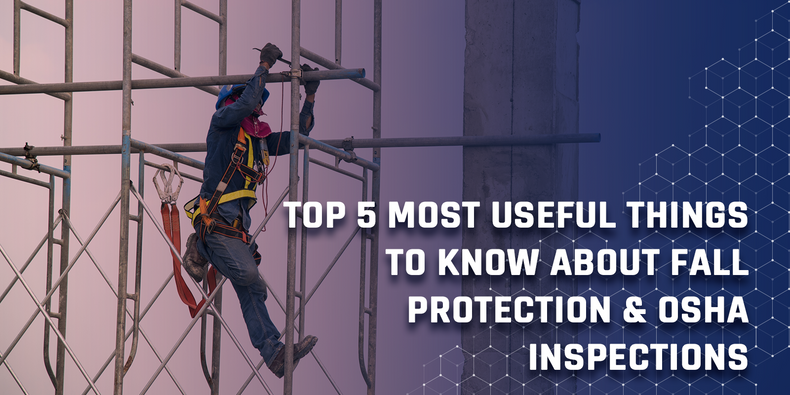If you are running a business where Fall Protection Gear is used, there is a lot you need to know about OSHA standards. While the need to keep high quality, well inspected Fall Protection Equipment should be a no-brainer, you need to know what is expected of you to keep your workplace compliant.
If you are using Fall Protection Gear yourself on your job, it is also important for you to know a bit about these regulations in order to advocate for your own safety and to make sure that you are doing your part in meeting regulations.
1. What Types Of Gear Are Included In Fall Protection?
If you are reading this article, we assume that you know that Fall Protection Systems are assemblies to keep you safer when you are climbing, especially at those great heights.
OSHA has three major categories of Fall Protection Equipment that each have their own specific regulations.
The Three Categories Of Fall Protection Equipment:
- Lanyards
- Harnesses
- Retractable Devices
2. Who Can Perform Inspections On Fall Protection Equipment?
OSHA standards regarding Fall Protection mostly refer to a “Competent Person” who is designated by a company to perform inspections.
A Competent Person As Defined By OSHA:
“One who is capable of identifying existing and predictable hazards in the surroundings, or working conditions which are unsanitary, hazardous, or dangerous to employees, and who has authorization to take prompt corrective measures to eliminate them.” [OSHA 29 CFR 1926.32(f)]
A “Competent Person” is designated by a company to have the last say on whether or not a piece of gear is safe or not for Fall Protection purposes. In other words, nobody at the company, including managers or the owner, can override a Competent Person’s decision that equipment is unsafe.
The Designated Competent Person must become certified with proper training that meets OSHA standards.
In many cases companies may hire an outside, third party person to inspect gear. This can sometimes add extra validity to the process and also offers a fresh set of eyes for inspections. In some cases, it may also be a more cost effective way to perform inspections.
3. How Often Does Fall Protection Gear Need To Be Inspected?
Universally all Fall Protection Equipment should be inspected before and after each use and at the start of each 8 hour shift. In addition to these visual inspections, all gear must be given a more formal and documented inspection by a Designated Competent Person at least once every 12 months.
Times Gear Needs To Be Inspected:
- Documented Inspections Must Be Performed By A Designated Competent Person At Least Every 12 Months
- Less Formal Inspections Must Be Conducted At The Start Of Every 8 Hour Shift
- Additional Informal Inspections Must Be Conducted Before And After Each Use
4. What Are Common OSHA Violations That People Miss?
While performing daily inspections, there are some things you should look out for in particular. Arc burns, chemical damage, heat damage, and minor cuts are all things to look out for.
One of the more obscure OSHA standards is in regards to harnesses. When not in use, harnesses must be stored in a cabinet to avoid additional exposure to light and UV Rays.
If a Competent Person observes discoloration from UV Rays in a harness during an inspection, you should expect that they will deem the harness to be unfit for use. This may seem trivial, but if a harness has been put through enough exposure to show discoloration it will also show a reduction in strength and integrity.
Common Damages That Are Often Missed Before Inspection:
- Dirt
- Arc
- Burns
- Brittleness
- Minor Cuts
- Heat Damage
- Bent Hardware
- Chemical Damage
- Discoloration From Sun Exposure
5. What Fall Protection Gear Can Be Repaired?
Gear that shows visible signs of wear should be retired or at the very least repaired by the manufacturer.
Authorized Repair Service Departments from manufacturers are the only people or institutions accepted by OSHA standards for restoring Fall Protection Gear and there are significant limits to what they can do.
Unfortunately, most gear that shows any significant wear or that has been involved in a fall must be retired without considering repairs.
The Breakdown On What Gear Can Be Repaired:
- Lanyards Are Not Authorized To Be Repaired
- Harnesses Are Not Authorized To Be Repaired
- Retractable Devices Can Be Repaired Only By Authorized Repair Services
- Nearly All Equipment Involved With A Fall Will Need To Be Retired Permanently
Why This Information Should Be Important To You
The obvious and most important reason to be concerned about meeting OSHA regulations for Fall Protection Equipment is workplace safety. The reasons that these standards are so stringent and black & white are all related to the fact that workers’ lives are on the line.
In terms of liability, these regulations should be followed closely to protect companies and the people who work for them.
The good news is that most Fall Protection Equipment is fairly inexpensive. The financial cost of failing to comply is astronomically higher than any money spent on replacing old or damaged gear. It should go without saying that the ethical price of someone becoming injured or killed on a job due to neglect is immeasurable.


